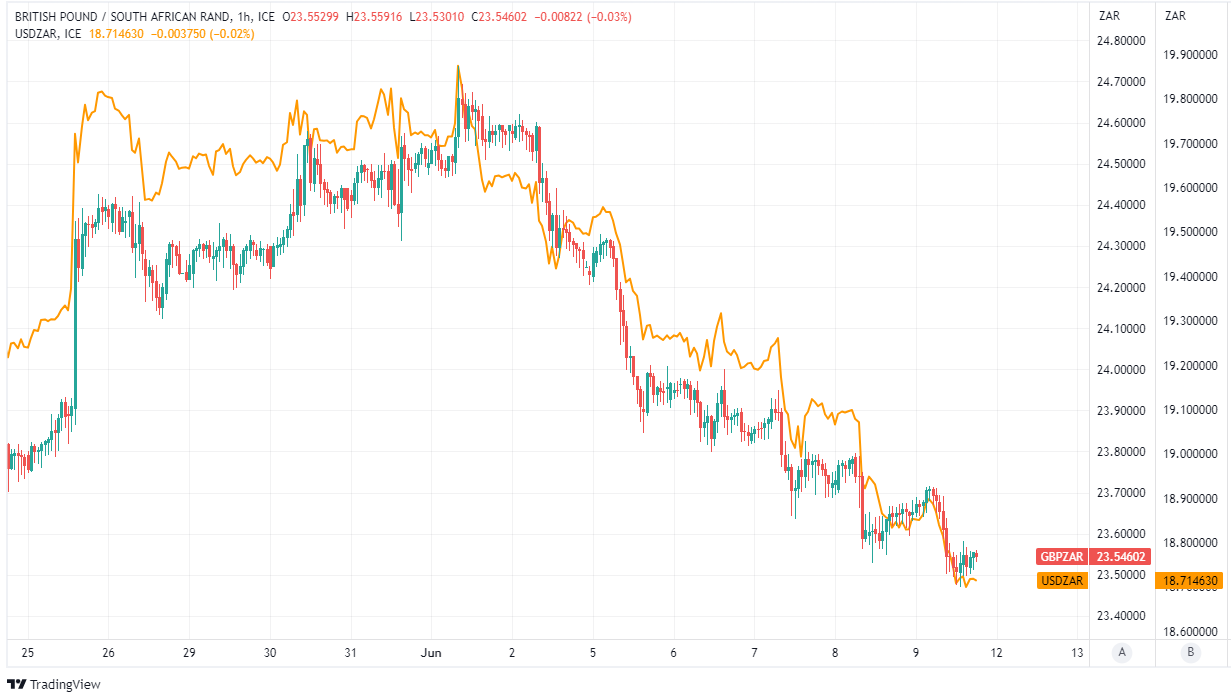South African Rand Benefits as Dollar and Renminbi Losses Extend
- Written by: James Skinner
-
"From August, Eskom is likely to reduce loadshedding which, combined with a weaker dollar, should drive the USDZAR lower towards 18 by year-end" - BofA Global Research.

© Lefteris Papaulakis, Adobe Images
The South African Rand outperformed while pushing GBP/ZAR to a one-month low ahead of the weekend as it appeared to benefit from extended losses in U.S. Dollar and Chinese Renminbi exchange rates.
South Africa's Rand rallied against almost all counterparts in the G20 basket on Friday when the Norwegian Krone, Russian Rouble and Brazilian Real were the only other currencies in the group to rise more broadly against a mostly-falling U.S. Dollar.
Falling Dollar rates also had their own domestic drivers but may have been further weighed down by a depreciating Renminbi while the Rand is known to benefit from declines in the greenback while having a variable correlation with the Renminbi.
"The 10y CNYGB yield fell 2bp to 2.70% and the front-end 1y yield dropped 5bp to 1.94% as speculation builds of PBoC policy easing amid deepening factory price deflation and underwhelming economic activity," writes Kenneth Broux, an FX strategist at Societe Generale, in a Friday market commentary.
"A minority of analysts forecast a reduction in the 1y MLF rate next week," he adds.
Above: GBP/ZAR shown at hourly intervals alongside USD/ZAR. To optimise the timing of international payments you could consider setting a free FX rate alert here.
Chinese banks were reported to already be slashing interest rates this week and there was speculation on Friday suggesting the central bank could follow suit next week after inflation underwhelmed economist forecasts for the month of May.
Yields on Chinese government bonds have fallen this year and now sit far beneath those of many developed markets due partly to a yawning gap between inflation in China and elsewhere, while the yield differential would be reinforced by any rate cut next week.
If that or similar led the market to sell the Renminbi for other currencies this week, it could also be expected to have weighed on the Dollar because selling RMB/XYZ on the interbank market requires Dollars to be bought first before being sold for the third currency: This results from the Dollar intermediated structure of the market.
"The trade-weighted renminbi CFETS' depreciation trend is persisting even if USD/CNY has been plateauing lately around 7.13. The EUR/CNY cross rate has broken to fresh highs," says Alvin Tan, head of Asia FX strategy at RBC Capital Markets. "It does look increasingly as if the trade-weighted CFETS Index is on a controlled depreciation path."
Dollar exchange rates also had reason to depreciate themselves in the latter half of the week, however, with a sharp rise in new unemployment-related welfare claims leading U.S. government bond yields to fall and expectations for the Federal Reserve (Fed) interest rate to moderate ahead of next Wednesday's policy decision.
Meanwhile, the Rand could have found a reason for cheer in the recently-reduced intensity of load-shedding at national electricity monopoly Eskom and in South African GDP figures released on Tuesday, which showed Africa's largest economy escaping the clutches of recession in the opening quarter.
Above: GBP/ZAR shown at daily intervals alongside USD/ZAR and Dollar-Renminbi rate. To optimise the timing of international payments you could consider setting a free FX rate alert here.
"The likelihood of stage 8 loadshedding (i.e., 8,000MW shed from national grid) could push USDZAR above 20 in the months ahead. This is consistent with the view from our technical strategy team," says Mikhail Liluashvili," a strategist at BofA Global Research.
"Temporarily reaching Stages 8-10 looks highly possible, but the risk of grid collapse looks low. From August, Eskom is likely to reduce loadshedding which, combined with a weaker dollar, should drive the USDZAR lower towards 18 by year-end," Liluashvili writes in a Friday research briefing.
Whatever the cause of the South African Rand's rally in the latter half of the week, it's likely to be sensitive along with other currencies next Tuesday when U.S. inflation figures for the month of May are released almost immediately ahead of the June Federal Reserve decision.
Economist expectations are for the Fed's interest rate to be left unchanged next Wednesday but last month's prices data suggested the all-important core inflation rate, which central bankers view as the best reflection of domestic inflation pressures, ticked higher following a lengthy nine-month decline.
Another uptick next Tuesday would potentially be indicative of a more persistent inflation problem and would risk leading the Fed to surprise the market with another increase in its interest rate next Wednesday.

